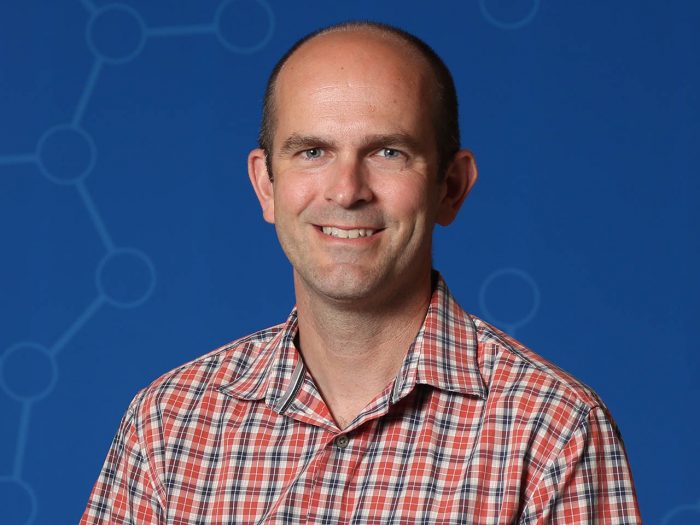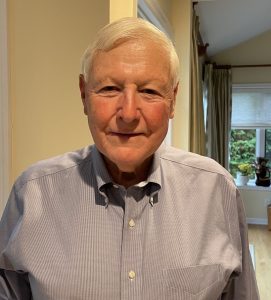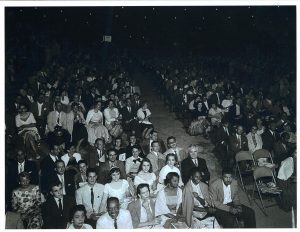By Barbara Anne Kirshner
Do you have close-knit forever friends applauding your successes as well as offering encouragement during challenging times? If your answer is yes, then you are truly lucky to have such treasures in your life. The Marvelous Wonderettes, a feel good musical romp back to the 50’s and 60’s now playing at Theatre Three, follows four such friends as they navigate life’s often unpredictable twists and turns together.
Playwright Roger Bean was approached by the Milwaukee Repertory Theatre to write a small-scale musical for their black box space. With constrictions such as little room backstage, Bean wrote the one-act version of The Marvelous Wonderettes produced in 1999. He got the inspiration for the musical from a conversation with his mother about when she was a high school song leader and part of a singing trio. Bean also credits his mother for instilling in him a love of 50’s and 60’s music.
That Milwaukee production was so successful that the theatre revived it in 2001, this time as a full-scale two-act musical. Then came the Los Angeles production in 2006 followed by a smash Off-Broadway run in 2008 with an Off-Broadway revival in 2016.
It’s prom night, 1958, at Springfield High School and song leaders, Betty Jean (Cassidy Rose O’Brien), Cindy-Lou (Noelle McLeer), Missy (Kate Keating) and Suzy (Ashley Brooke) in frilly crinoline dresses, wrist corsages and teased up hair burst onstage delivering a bouncy rendition of “Mr. Sandman” followed by “Lollipop” and segue into “Sugartime.” When Cindy-Lou steals the microphone and belts out Betty Jean’s signature song “Alleghany Moon,” slapstick antics of trying to upstage each other ensue thus highlighting their competitive natures and the hilarious tone of the show.
The girls explain to the crowd that they are last minute stand-ins for the evening’s entertainment. It seems the boys’ glee club lost the gig after lead singer Billy Ray Patton was suspended for smoking behind the girls locker room. They go on to announce the theme for this year’s prom, “Marvelous Dreams,” and break into a rapturous “All I Have to Do Is Dream” followed by “Dream Lover.”
Each girl in this ensemble is as unique as the individual colors they wear with Betty Jean and her all-American looks in lime green, the bespectacled and comedic Missy in orange, ditzy gum chewer Suzy in blue and self-centered Cindy-Lou in pink.
A nice choice of playwright Bean was to set Act II ten years later reuniting the girls at their 1968 class reunion. This act is brimming with pop 60’s tunes. The crinoline has now been replaced by flowing robes trimmed with feathers, knee high white go-go boots and hoop earrings. A lot has changed for each girl, but they come together once more in harmony realizing they have a bond that stands the test of time.
All four of these actresses deliver powerhouse performances with dynamic acting, rich voices and lithe dancing. Keating’s Missy is passionate as she reveals her crush in “Secret Love” and then gives a standout version of “Mr. Lee” replete with impressive, sustained notes that receive spirited applause from the audience.
Brooke’s Suzy punctuates Act I with an exuberant “Hold Me, Thrill Me, Kiss Me” and then delivers an intense “Maybe I Know” in Act Two. O’Brien’s Betty Jean explodes in a heart-wrenching “You Don’t Own Me” followed by “That’s When the Tears Start” and McLeer’s Cindy-Lou sends chills in “Son of a Preacher Man” into “Leader of the Pack.”
It must be noted there is some humorous audience participation that puts the crowd right in the center of all the action.
Linda May’s direction keeps the festivities lively. She has created an ensemble that holds on to the audience from their first effervescent entrance until their final bow. Sari Feldman’s stylized choreography is reminiscent of the best girl groups of that era. Costumes by Ronald Green III are a cornucopia of colors and fabrics. Green’s attention to detail accentuates the 50’s and 60’s flavor of the show.
The band under the musical direction of Cesar Flores is built into the backdrop so they are onstage for the entire show keeping the energy high. Tim Haggerty’s sound design infuses exhilaration to each number.
Scenic design by Randall Parsons offers a buoyancy even before the show begins with a pink backdrop and sparkling fringe bordering the band shell. Lighting design by Robert W. Henderson, Jr. generates vibrancy to songs like “Lollipop” and “Wedding Bell Blues” as well as mood lighting with “Hold Me, Thrill Me, Kiss Me” and “That’s When the Tears Start.” The disco ball swirling blue spots around the theater is a nice touch to close Act I. Heather Rose Kuhn’s properties joins in the fun with giant lollipops, a hanging crescent moon and bubbles.
Theatre Three’s The Marvelous Wonderettes is such a fast-paced delight that at the end you can’t believe it’s over already. See it with your best friends — you’ll be glad you did!
Theatre Three, 412 Main St., Port Jefferson presents The Marvelous Wonderettes through March 26. Tickets are $35 adults, $28 seniors and students, $20 children ages 5 and up. For more information or to order, call 631-928-9100 or visit www.theatrethree.com.





























